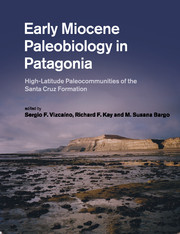Book contents
- Early Miocene Paleobiology in Patagonia
- Frontispiece
- Early Miocene Paleobiology in Patagonia
- Copyright page
- Contents
- Contributors
- Preface
- 1 Background for a paleoecological study of the Santa Cruz Formation (late Early Miocene) on the Atlantic Coast of Patagonia
- 2 Tephrochronology of the Miocene Santa Cruz and Pinturas Formations, Argentina
- 3 Absolute and relative ages of fossil localities in the Santa Cruz and Pinturas Formations
- 4 Sedimentology and paleoenvironment of the Santa Cruz Formation
- 5 Oysters from the base of the Santa Cruz Formation (late Early Miocene) of Patagonia
- 6 Ichnology of distal overbank deposits of the Santa Cruz Formation (late Early Miocene): paleohydrologic and paleoclimatic significance
- 7 Fossil plant studies from late Early Miocene of the Santa Cruz Formation: paleoecology and paleoclimatology at the passive margin of Patagonia, Argentina
- 8 Amphibians and squamate reptiles from the Santa Cruz Formation (late Early Miocene), Santa Cruz Province, Argentina: paleoenvironmental and paleobiological considerations
- 9 Diversity and paleobiology of the Santacrucian birds
- 10 Paleoecology of the Paucituberculata and Microbiotheria (Mammalia, Marsupialia) from the late Early Miocene of Patagonia
- 11 Paleoecology of the mammalian carnivores (Metatheria, Sparassodonta) of the Santa Cruz Formation (late Early Miocene)
- 12 Paleobiology of Santacrucian glyptodonts and armadillos (Xenarthra, Cingulata)
- 13 Paleobiology of the Santacrucian sloths and anteaters (Xenarthra, Pilosa)
- 14 Paleobiology of Santacrucian native ungulates (Meridiungulata: Astrapotheria, Litopterna and Notoungulata)
- 15 Paleobiology of Santacrucian caviomorph rodents: a morphofunctional approach
- 16 Paleobiology of Santacrucian primates
- 17 A review of the paleoenvironment and paleoecology of the Miocene Santa Cruz Formation
- Index
15 - Paleobiology of Santacrucian caviomorph rodents: a morphofunctional approach
Published online by Cambridge University Press: 05 June 2013
- Early Miocene Paleobiology in Patagonia
- Frontispiece
- Early Miocene Paleobiology in Patagonia
- Copyright page
- Contents
- Contributors
- Preface
- 1 Background for a paleoecological study of the Santa Cruz Formation (late Early Miocene) on the Atlantic Coast of Patagonia
- 2 Tephrochronology of the Miocene Santa Cruz and Pinturas Formations, Argentina
- 3 Absolute and relative ages of fossil localities in the Santa Cruz and Pinturas Formations
- 4 Sedimentology and paleoenvironment of the Santa Cruz Formation
- 5 Oysters from the base of the Santa Cruz Formation (late Early Miocene) of Patagonia
- 6 Ichnology of distal overbank deposits of the Santa Cruz Formation (late Early Miocene): paleohydrologic and paleoclimatic significance
- 7 Fossil plant studies from late Early Miocene of the Santa Cruz Formation: paleoecology and paleoclimatology at the passive margin of Patagonia, Argentina
- 8 Amphibians and squamate reptiles from the Santa Cruz Formation (late Early Miocene), Santa Cruz Province, Argentina: paleoenvironmental and paleobiological considerations
- 9 Diversity and paleobiology of the Santacrucian birds
- 10 Paleoecology of the Paucituberculata and Microbiotheria (Mammalia, Marsupialia) from the late Early Miocene of Patagonia
- 11 Paleoecology of the mammalian carnivores (Metatheria, Sparassodonta) of the Santa Cruz Formation (late Early Miocene)
- 12 Paleobiology of Santacrucian glyptodonts and armadillos (Xenarthra, Cingulata)
- 13 Paleobiology of the Santacrucian sloths and anteaters (Xenarthra, Pilosa)
- 14 Paleobiology of Santacrucian native ungulates (Meridiungulata: Astrapotheria, Litopterna and Notoungulata)
- 15 Paleobiology of Santacrucian caviomorph rodents: a morphofunctional approach
- 16 Paleobiology of Santacrucian primates
- 17 A review of the paleoenvironment and paleoecology of the Miocene Santa Cruz Formation
- Index
Summary
Caviomorphs constitute a monophyletic group, representative of the oldest rodent radiation in South America. Since the Oligocene they have contributed importantly to the fossil communities of South American mammals. Today, caviomorphs display a diverse array of locomotor and feeding behaviors, occupying a wide range of habitats in which they consume a variety of food items. In this contribution, we analyze species of Santacrucian caviomorphs from a morphofunctional perspective in the context of extant caviomorph behavioral diversity, in order to evaluate their paleobiology and its paleoenvironmental significance. Body masses based on Santacrucian specimens were estimated by applying published equations. Reconstructions were made of areas of origin and insertion of the main masticatory muscles following the muscular pattern observed in living caviomorphs. On this basis, functional analyses of the masticatory apparatus were performed. Major postcranial features in extant caviomorphs identified as functionally associated with different locomotor habits were used as a model to evaluate the functional significance of the postcranial features in Santacrucian species. Santacrucian caviomorphs examined show the range of body mass from small- to relatively large-sized living caviomorphs. The porcupine Steiromys duplicatus and the dasyproctid Neoreomys australis present features that indicate a diet of harder and more abrasive food items than those consumed by living Neotropical phylogenetically related species. Features of the masticatory apparatus of the eocardiid Eocardia fissa are compatible with a wide feeding behavior, including abrasive food. Steiromys duplicatus was a semi-arboreal form, which did not achieve the degree of specialization that is seen in the Neotropical extant Coendou. Eocardia fissa was a cursorial agile rodent, similar to living Pediolagus salinicola. Neoreomys australis was a cursorial species, more similar to living Agouti paca than to Dasyprocta species. Santacrucian caviomorphs could have lived in an environment like the Cerrado biome, showing differential utilization of food resources and locomotor behaviors.
- Type
- Chapter
- Information
- Early Miocene Paleobiology in PatagoniaHigh-Latitude Paleocommunities of the Santa Cruz Formation, pp. 287 - 305Publisher: Cambridge University PressPrint publication year: 2012
- 21
- Cited by



